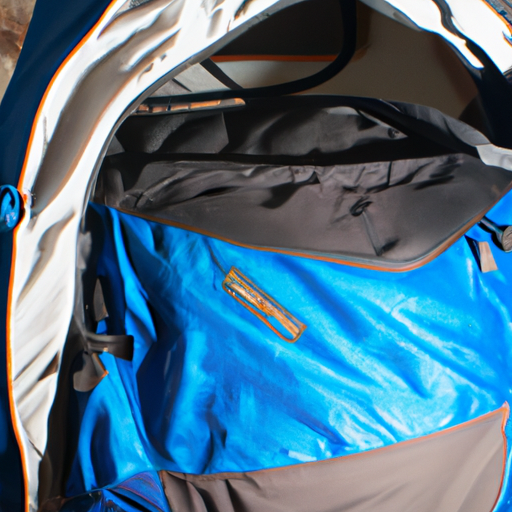How To Pack A Tent Into A Backpack
Are you an avid camper but struggle with the challenge of packing your tent into a backpack? Look no further! This article provides you with a comprehensive guide on how to efficiently pack a tent into your backpack. From folding techniques to organizing tips, we’ve got you covered. Say goodbye to bulky, unmanageable loads and hello to a compact and hassle-free camping experience. Read on to learn the tricks of the trade and make your next outdoor adventure a breeze. Let’s dive in!
Choosing the Right Backpack
When it comes to packing your tent into a backpack, the first thing you need to consider is the backpack’s capacity. choosing a backpack with the appropriate size for your tent is essential to ensure a proper fit and minimize strain on your body. Look for a backpack that has enough space to accommodate your tent along with other camping essentials without feeling overcrowded. It’s always a good idea to check the specifications of the backpack and compare it with the dimensions and weight of your tent before making a purchase.
Additionally, it’s beneficial to look for a backpack with specialized compartments. These compartments allow you to keep your tent separate from other items, such as clothes or cooking equipment, which can help keep everything organized and easily accessible. Some backpacks even have dedicated compartments specifically designed to accommodate tents, ensuring a snug and secure fit.
Another important feature to consider when choosing a backpack for packing your tent is the sturdy frame. A backpack with a sturdy frame not only provides structural support but also helps distribute the weight evenly, reducing strain on your shoulders and back. Look for backpacks with internal frames made of durable materials such as aluminum or fiberglass. These frames add stability and ensure the backpack can withstand the weight of your tent and other gear.
Lastly, check for adjustable straps and padding. Adjustable straps allow you to customize the fit of your backpack, ensuring maximum comfort during your hiking or camping trips. Look for padded shoulder straps and hip belts, as they provide additional support and help distribute the weight of the backpack more evenly. Comfort should always be a priority to prevent discomfort or injury while carrying your tent for extended periods.
Preparing the Tent
Before packing your tent into a backpack, it’s crucial to properly clean and dry it. A dirty or damp tent can lead to mildew or mold growth, which can damage the fabric and compromise the performance of your tent. Set up the tent in a well-ventilated area and wipe off any dirt or debris from the surface. Make sure to let it fully air dry before proceeding to pack it away.
To ensure an organized packing process, it’s best to separate and organize the tent components. This includes the tent body, rainfly, poles, stakes, and guy lines. Fold each component neatly and consider grouping them together to make it easier when setting up the tent later. Keeping the components organized also helps prevent any accidental damage during transportation.
When it comes to packing tent stakes and guy lines, it’s advisable to pack them separately. Tent stakes can be sharp and pose a risk of puncturing your tent’s fabric if not packed properly. Pack the stakes in a separate bag or use a designated pocket in your backpack to keep them secure. As for the guy lines, it’s best to roll them up and pack them separately to avoid tangling or knotting with other items.
Consider using a waterproof bag or stuff sack specifically designed for tents to provide an additional layer of protection. These bags not only keep your tent dry but also help compress it, making it easier to pack and saving valuable space in your backpack.
Rolling Method
The rolling method is a popular technique for packing tents and offers a compact and efficient way to store your tent in your backpack. Here’s a step-by-step guide on how to use the rolling method effectively:
Step 1: Lay out the tent flat, preferably on a clean and dry surface. This will help you remove any excess dirt or debris before packing.
Step 2: Remove any excess air from the tent by gently pressing down on it. Once the tent is relatively flat, fold it into a compact shape. You may need to fold the tent several times, depending on its size.
Step 3: Start rolling the tent tightly from one end to the other. Make sure to keep the roll as tight and compact as possible to save space in your backpack.
Step 4: Once the tent is rolled, secure it with straps or compression sacks to prevent it from unraveling during transportation. This ensures that your tent remains compact and occupies minimal space in your backpack.
The rolling method is handy when you have limited space in your backpack as it allows for efficient organization and utilizes the full capacity.
Folding Method
The folding method is an alternative technique that works well if you have enough space in your backpack or if you prefer a different approach to packing your tent. Here’s a step-by-step guide on how to use the folding method:
Step 1: Lay out the tent flat, ensuring that it is clean and dry. This prevents any dirt or moisture from being trapped inside while packing.
Step 2: Fold the tent into thirds or quarters, depending on its size. Start by folding one side towards the center and then fold the other side to meet it. Repeat this process until the tent is folded into a compact shape.
Step 3: Make sure the folded size fits the dimensions of your backpack. You may need to adjust the folds to ensure a proper fit and avoid any unnecessary bulges or protrusions.
Step 4: To secure the folded tent, use straps or compression sacks. These will keep the tent in a tidy and compact form, making it easier to pack and carry.
While the folding method may take up more space compared to the rolling method, it provides greater accessibility and allows for easier unpacking when setting up your tent at the campsite.
Pack the Tent at the Bottom
When it comes to packing your tent, it’s generally advised to pack it at the bottom of your backpack. There are several reasons why this is beneficial:
-
Protection: Placing the tent at the bottom provides an added layer of protection from any sharp or heavy items you may have in your backpack. It helps shield the tent from potential damage or punctures.
-
Weight distribution: By packing the tent at the bottom, you help distribute the weight evenly throughout your backpack. This promotes better balance and prevents strain on your back and shoulders.
-
Stability: Having the tent at the bottom creates a stable base for your backpack, especially if it has a sturdy frame. This stability translates into better comfort and maneuverability during your hiking or camping trips.
To further protect your tent, consider using a waterproof pack liner or cover. These additional layers keep your tent dry and shield it from any water or moisture that may seep into your backpack.
Pack Tent Poles and Stakes
In addition to packing the tent itself, it’s essential to consider the proper storage of tent poles and stakes. Here are some tips to help you organize and pack these components effectively:
Organize and pack tent poles together to prevent them from getting lost or damaged. Most tents come with a separate bag or sleeve for poles. If your tent doesn’t include one, consider purchasing a tent pole bag or using a piece of fabric to store them securely. Make sure the poles are clean and dry before packing.
When it comes to tent stakes, it’s important to choose a suitable storage option. Tent stakes can be sharp, so it’s crucial to keep them separate from other items to prevent any accidental damage. Consider using a small bag or fabric sleeve specifically designed for tent stakes. This will not only keep them secure but also prevent them from scratching or puncturing other gear in your backpack.
Ensure that both the tent poles and stakes are packed in a way that keeps them secure and easily accessible when needed. You can place them in the outer pockets of your backpack or use designated compartments within the backpack to keep them organized.
Consider Weight Distribution
Proper weight distribution is crucial when packing your tent into a backpack. By distributing the weight evenly, you ensure better balance and minimize strain on your body during your outdoor adventures. Here are some tips to help you achieve optimal weight distribution:
Distribute the weight of your tent evenly within the backpack. Avoid concentrating all the tent’s weight in one area, as this can lead to discomfort or even back pain. Instead, aim to distribute the weight evenly throughout the backpack.
Place heavier items, such as the tent poles or cooking equipment, closer to your back. This positioning helps keep the center of gravity of your backpack balanced, allowing for better stability while hiking or navigating rough terrain.
Utilize the hip belt and shoulder straps of your backpack for additional support. Adjust them to fit snugly and comfortably, as they play a crucial role in distributing the weight and relieving strain on your back and shoulders.
Proper weight distribution not only ensures a more comfortable hiking experience but also reduces the risk of injuries or fatigue during your outdoor adventures.
Utilize Outer Backpack Pockets
When packing your tent, it’s important to make the most of every available space in your backpack, including the outer pockets. Here’s how you can utilize these external pockets for additional storage:
Identify and use external pockets that are specifically designed for extra storage. These pockets are usually positioned on the sides or front of your backpack and can come in various shapes and sizes. Take advantage of these pockets to store smaller tent accessories or items that you frequently need to access, such as a headlamp or trail map.
Place smaller tent accessories, like tent stakes or guy lines, in the outer pockets. This not only helps keep these items organized but also makes it easier to locate them when setting up or taking down your tent.
Keep frequently used items easily accessible by placing them in the outer pockets. This can include items like a water bottle, snacks, or a rain jacket. Having these essentials within reach saves time and effort during your outdoor adventures.
By utilizing the outer backpack pockets effectively, you can optimize the storage space and ensure quick access to essential items while on the trail.
Keep Fragile Items Separate
To ensure the safety of your tent and other gear, it’s important to keep fragile tent components separate from other items. Here are some tips to help you protect fragile items during transportation:
Separate fragile tent components, such as the rainfly or tent body, from other gear in your backpack. This prevents any potential damage caused by sharp or bulky items.
Consider using protective cases or pouches for delicate tent components. These cases not only keep the items safe but also provide additional cushioning against any impact or pressure during transportation.
Utilize internal pockets or compartments within your backpack to provide added protection for fragile items. This helps prevent any accidental tearing or scratching while on the move.
Taking extra precautions to keep fragile items separate ensures that your tent and other gear arrive at the campsite in perfect condition, ready for use.
Practice Proper Weight Distribution
While weight distribution is important, it’s equally crucial to avoid carrying excessive weight in your backpack. Carrying too much weight can lead to discomfort, fatigue, and increased strain on your body. Here’s how you can practice proper weight distribution:
Avoid carrying unnecessary items or gear that you won’t be using during your camping trip. This will help minimize the overall weight of your backpack and prevent unnecessary strain.
Distribute the weight evenly between your shoulders. Avoid favoring one side over the other, as this can lead to muscle imbalances and discomfort during your hike.
Take shorter breaks or rests to reduce the strain on your body. By taking frequent short breaks, you allow your muscles to recover and prevent excessive fatigue.
Remember, the key is to find a balance between carrying the necessary gear and maintaining a comfortable weight for your backpack. A well-distributed load ensures an enjoyable and stress-free hiking experience.
In conclusion, packing a tent into a backpack requires careful consideration of various factors. Choosing the right backpack, organizing the tent components, and utilizing proper packing methods are all essential steps. Additionally, ensuring weight distribution, utilizing outer backpack pockets, and protecting fragile items are crucial for a successful and comfortable hiking or camping trip. By following these guidelines, you can confidently pack your tent into a backpack, ready to embark on your next outdoor adventure.




